Solar Energy Solutions Company Financial Model
This 3-Statement Solar Energy Solutions Company Financial Model in Excel includes revenue streams from panel sales, EV Charger accessories and installations. Financial statements to forecast the financial health of your renewables business.
Financial Model For A Solar Energy Solutions Company
Here is a detailed description of a 3-statement financial model specifically tailored for a solar solutions provider. It includes breakdowns for the Income Statement, Cash Flow Statement, and Balance Sheet, with revenue sources from selling solar panels, solar storage and batteries, EV chargers, and residential and commercial installation services. (All revenue sources are of course editable by the owner)
- Income Statement (Profit & Loss)
- Cash Flow Statement
- Balance Sheet
- Subscription Model Assumptions (6-tier pricing model)
Income Statement
The Income Statement provides an overview of revenues, costs, and profitability. Each revenue source and associated costs are explicitly modelled.
Revenue Streams
Selling Solar Panels
- Revenue = Units Sold × Average Selling Price.
- Cost of Goods Sold (COGS) = Units Sold × Cost Per Unit (manufacturing/procurement cost).
- Gross Profit = Revenue – COGS.
Selling Solar Storage and Batteries
- Revenue = Units Sold × Price Per Storage Unit.
- COGS = Units Sold × Unit Cost.
- Gross Profit = Revenue – COGS.
Selling EV Chargers
- Revenue = Units Sold × Average Selling Price (standard vs. premium options).
- COGS = Units Sold × Procurement/Production Cost.
- Gross Profit = Revenue – COGS.
Installation Services
- Residential Installation: Revenue = Number of Projects × Average Residential Project Value.
- Commercial Installation: Revenue = Number of Projects × Average Commercial Project Value.
- Direct Costs: Labor costs (technicians/installers), transportation, permits, and installation equipment.
- Gross Profit = Installation Revenue – Direct Costs.
Operating Expenses
- Marketing and Sales
- Customer acquisition costs, digital advertising campaigns, trade shows, etc.
- General and Administrative
- Salaries for office staff, office space, and other non-project-specific overheads.
- R&D and Product Improvement
- Research to improve battery efficiency, charger design, or cost-efficiency of solar panels.
- After-Sales Support
- Warranty expenses, maintenance staff costs.
Operating Income (EBIT) = Total Gross Profit – Total Operating Expenses.
Net Income
- Add/Subtract:
- Interest Expense (e.g., loans for production).
- Taxes.
- Net Income = EBIT – Interest – Taxes.
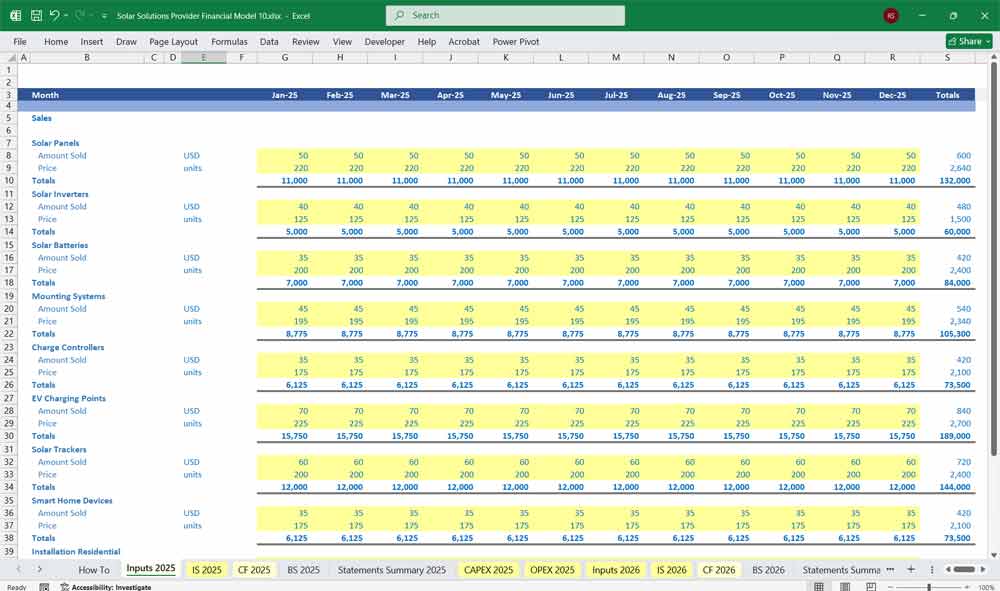
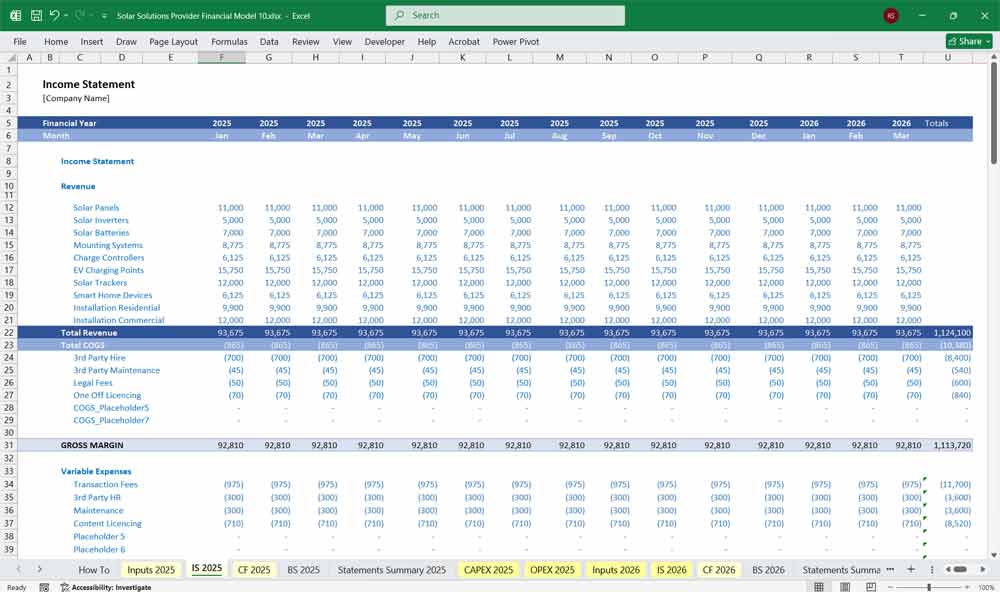
Solar Energy Solutions Cash Flow Statement
The Cash Flow Statement tracks the company’s liquidity by showing cash inflows and outflows from operating, investing, and financing activities.
Operating Activities
Cash Inflows:
- Revenue from selling solar panels, storage units, EV chargers, and installations.
- Deposits/advances from customers for upcoming installations.
Cash Outflows:
- Direct Costs:
- Payments to suppliers for solar panels, batteries, and chargers.
- Labor wages for installations.
- Operating Expenses:
- Marketing, administrative, R&D, and warranty-related expenses.
- Taxes Paid.
- Direct Costs:
Net Cash from Operations = Total Inflows – Total Outflows from Operations.
Investing Activities
Capital Expenditures (CapEx):
- Investments in production equipment or factories.
- EV charger development costs or R&D infrastructure.
- Acquisition of new vehicles or machinery for installations.
Investments in Technology:
- Development of software platforms to support monitoring, customer interaction, etc.
Net Cash from Investing Activities = Total Proceeds from Sales of Assets – CapEx and Investments.
Financing Activities
Debt Financing:
- Loans raised to procure raw materials or fund R&D.
- Repayment of principal or interest.
Equity Financing:
- New equity issuances for expansion or working capital.
Net Cash from Financing Activities = Cash Inflows (loans/equity) – Cash Outflows (interest payments/repayment).
Net Change in Cash Position = Sum of Cash Flows from Operating, Investing, and Financing Activities.
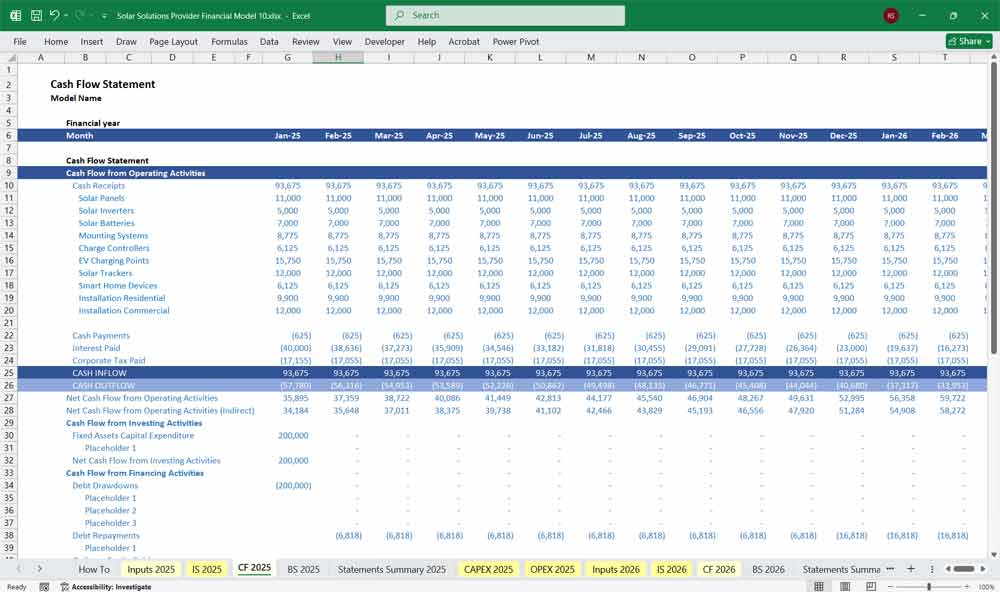
Solar Energy Solutions Balance Sheet
The Balance Sheet provides a snapshot of the company’s financial position at a point in time, detailing assets, liabilities, and equity.
Assets
Current Assets:
- Cash: Closing cash position from the Cash Flow Statement.
- Accounts Receivable: Outstanding invoices for solar panels, installations, or service contracts.
- Inventory:
- Solar panels, batteries, EV chargers, and installation materials.
- Work-in-progress (unfinished residential/commercial projects).
- Prepaid Expenses: Deposits paid for permits, licenses, or bulk material orders.
Non-Current Assets:
- Fixed Assets: Machinery, vehicles, and tools for installation.
- Intangible Assets: Patents, software platforms, and R&D developments.
Liabilities
Current Liabilities:
- Accounts Payable: Amounts owed to suppliers for raw materials.
- Short-Term Loans/Debt: Working capital loans.
- Deferred Revenue: Advances received from customers for projects not yet completed.
Non-Current Liabilities:
- Long-term loans for R&D, factory setup, or EV charger design development.
Equity
- Retained Earnings: Net income accumulated from previous years.
- Shareholder Equity: Initial and additional equity raised.
Assets = Liabilities + Equity.
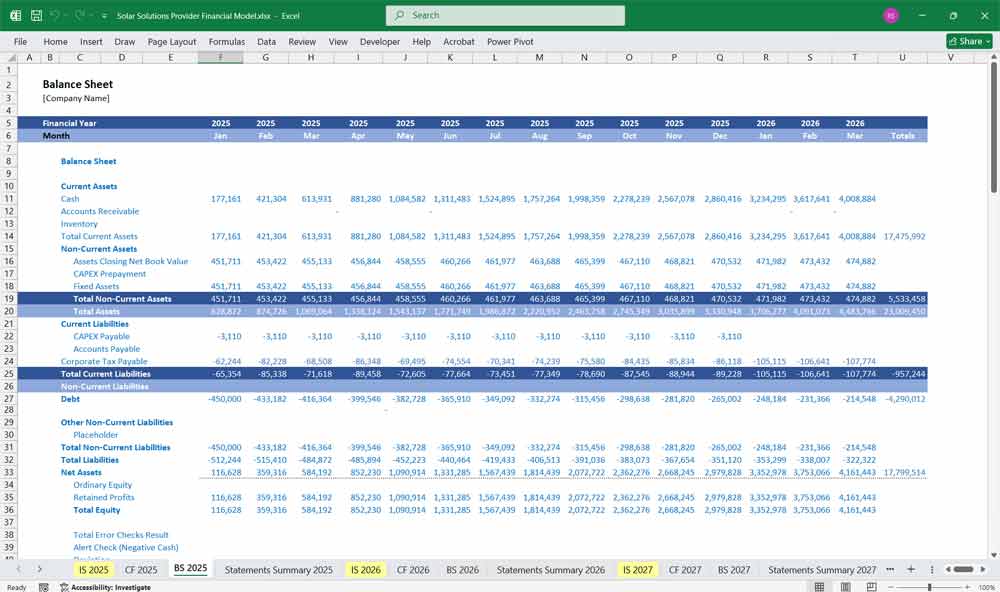
Use the solutions below? This financial model will be useful
Residential Solar Panel Sales
— Complete solar setups for powering homes, reducing energy bills, and increasing energy independence.
Commercial Solar Panel Sales
— Tailored solar energy systems for businesses, factories, and office buildings to optimize energy efficiency.
Portable Solar Solutions Power Kits
— Compact and lightweight solar kits for camping, RVs, boats, and outdoor activities.
Off-Grid Solar Systems
— Independent solar power solutions ideal for remote areas, cabins, and emergency backup power.
Grid-Tied Solar Systems
— Systems connected to the utility grid, allowing for net metering and reducing electricity costs.
Installation Of Hybrid Solar Systems
— Combines grid-tied and off-grid features with battery backup, ensuring uninterrupted power.
Installation Of Solar Roof Tiles
— Sleek, integrated solar roofing solutions that blend with traditional roofing materials while generating power.
Flexible Solar Panel Sales
— Lightweight, bendable solar panels perfect for irregular surfaces, RVs, and marine applications.
Installation and Sale Of Solar Carport Systems
— Solar-powered carports providing shade while generating electricity, ideal for homes and commercial parking lots.
Solar Water Pump Sales
— Efficient water pumping solutions for irrigation, livestock, and rural water supply using solar energy.
Solar Street Lighting Sales
— Standalone solar-powered street lights with dusk-to-dawn automation and motion sensors.
Solar Garden Light Sales
— Decorative, energy-efficient lighting for landscapes, pathways, and outdoor spaces.
Solar-Powered Security Camera Sales
— Surveillance systems powered by solar energy, perfect for remote or off-grid locations.
Solar Battery Storage Sales
— Energy storage systems to retain solar power for use during nighttime or cloudy conditions.
Lithium-Ion Solar Battery Sales
— High-performance, long-lasting batteries designed for solar energy storage with fast charging capabilities.
Deep Cycle Solar Battery Sales
— Reliable energy storage solutions for off-grid applications, delivering consistent power over long periods.
Solar Inverters (Hybrid, Grid-Tie, Off-Grid)
— Devices that convert solar-generated DC electricity into AC power for home and business use.
Micro Inverter Sales
— Small inverters attached to individual panels, enhancing performance and monitoring at the panel level.
Solar Charge Controller Sales
— Regulates voltage and current from solar panels to prevent battery overcharging and optimize efficiency.
MPPT Solar Charge Controllers
— Maximum Power Point Tracking controllers that improve efficiency by dynamically optimizing power output.
PWM Solar Charge Controllers
— Pulse Width Modulation controllers offering simple, cost-effective regulation for smaller solar setups.
Solar Power Bank Sale
— Portable battery packs charged by the sun, ideal for charging phones, tablets, and small devices on the go.
Solar Phone Charger Sale
— Compact solar-powered chargers designed for smartphones, wearables, and other small electronics.
Solar-Powered Generator Sale
— Silent, eco-friendly power stations perfect for emergencies, camping, and remote worksites.
Solar-Powered Refrigerator Sale
— Energy-efficient refrigeration solutions for homes, RVs, or off-grid use powered entirely by solar energy.
Solar-Powered Water Heater Sale
— Cost-saving water heating systems that use solar energy to provide hot water for homes and businesses.
Solar Monitoring Systems and Apps
— Real-time performance tracking and system diagnostics accessible from your smartphone or computer.
Solar Panel Mounting Structures
— Durable racking systems for securely mounting solar panels on rooftops, ground mounts, or poles.
Solar Panel Cleaning Kit Sale
— Specialized tools and cleaning solutions to maintain optimal solar panel performance.
Customized Solar Solutions for Industry
— Tailor-made solar energy projects designed to meet the unique energy needs of industrial facilities.
Integration of Statements
The financial model links the three statements seamlessly:
- Net Income from the Income Statement flows into Retained Earnings on the Balance Sheet.
- Depreciation reduces the value of fixed assets in the Balance Sheet and adds back to Operating Activities in the Cash Flow Statement.
- Ending Cash Balance from Cash Flow Statement flows to the Cash line on the Balance Sheet.
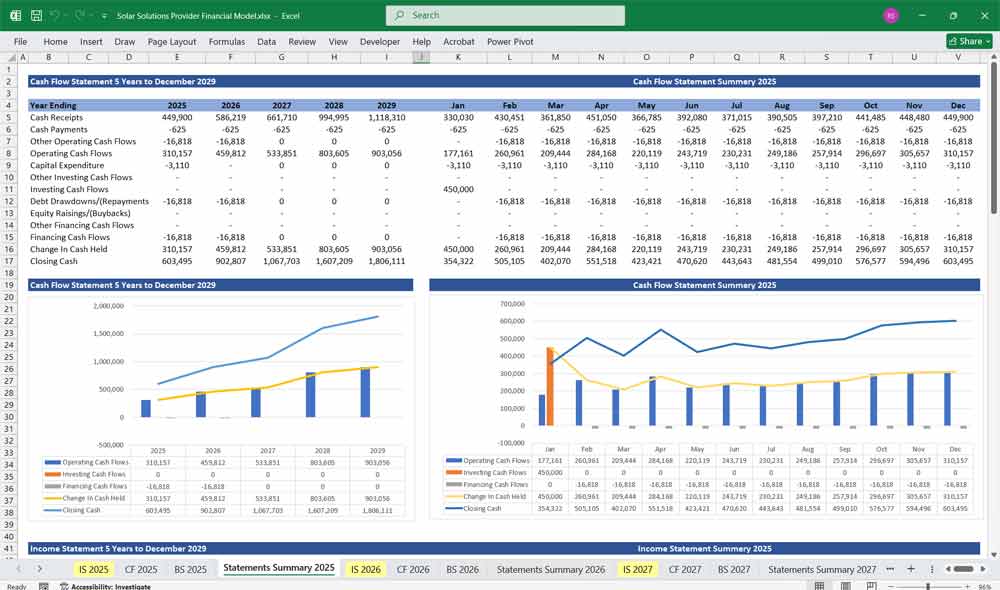

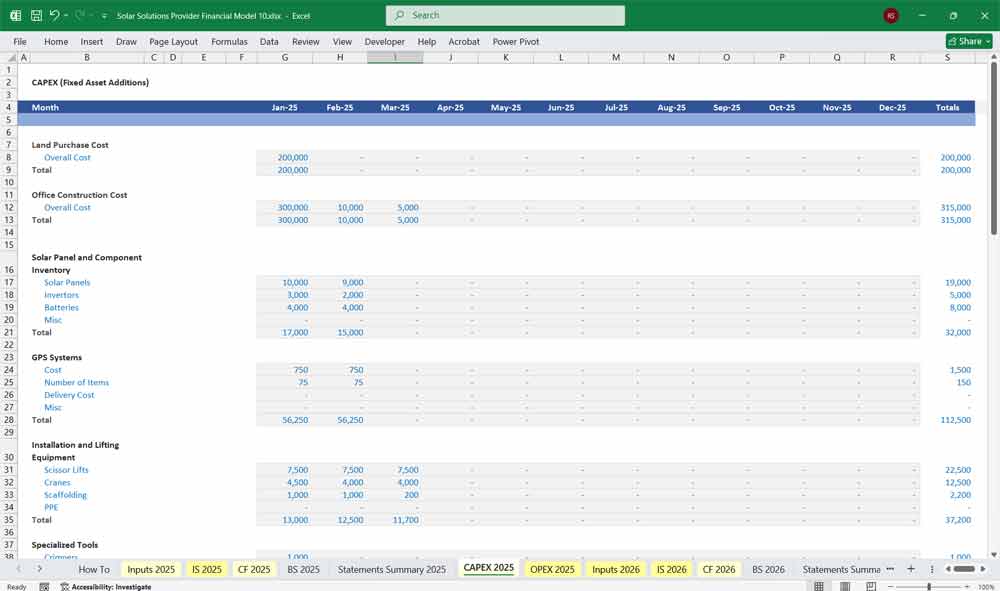

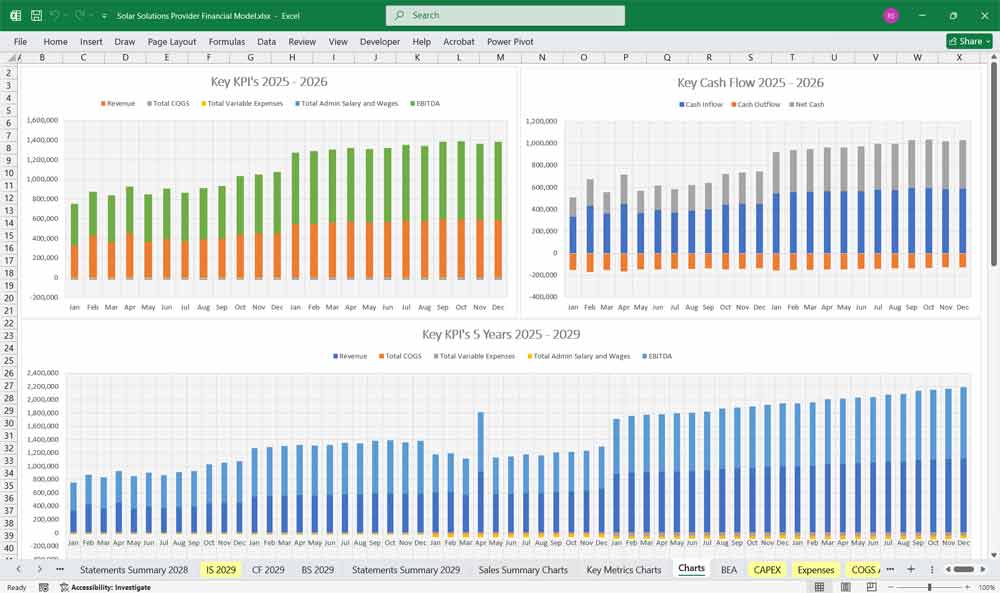



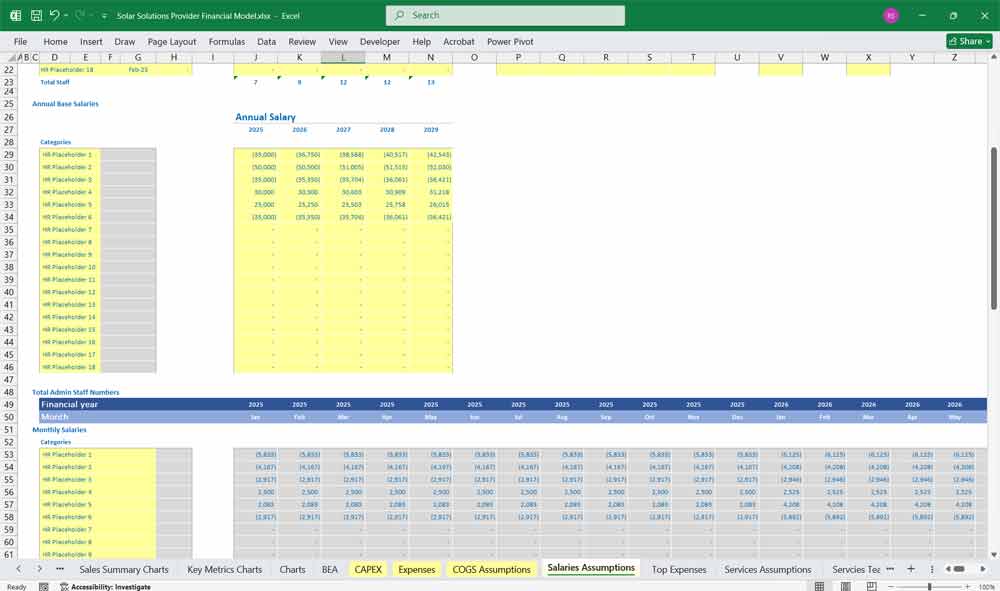
Additional Insights for For The Financial Model
Incorporate Key Ratios:
- Gross Margin = Gross Profit / Revenue.
- Operating Margin = EBIT / Revenue.
- Net Margin = Net Income / Revenue.
- Debt-to-Equity Ratio and Liquidity Ratios from the Balance Sheet.
Build Scenario Analyses to account for:
- Market growth in solar, battery, and EV segments.
- Fluctuations in costs (e.g., raw material price increases).
- Volume sensitivity: High, medium, and low sales assumptions.
This 3-statement Solar Energy Solutions Company Financial Model provides a comprehensive tool for evaluating the solar solutions provider’s performance and strategic planning for growth.
Download Link On Next Page
